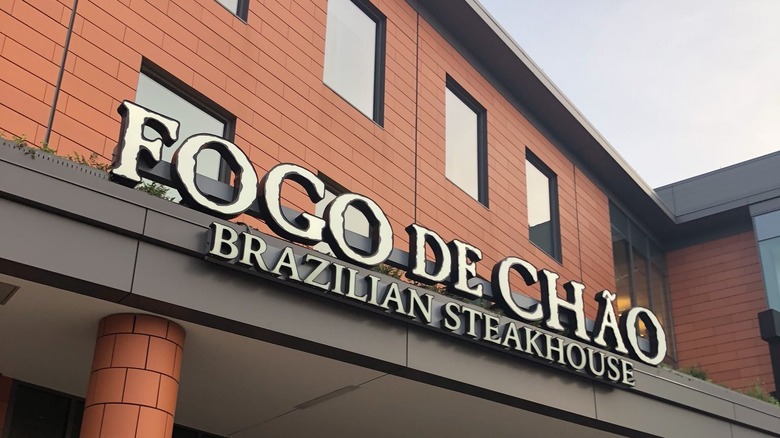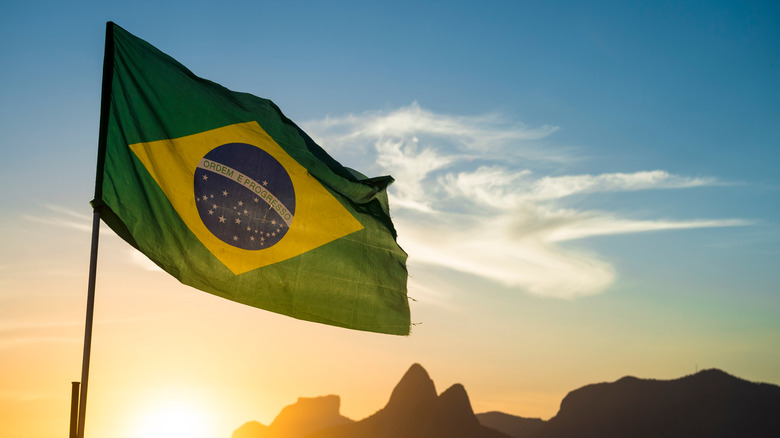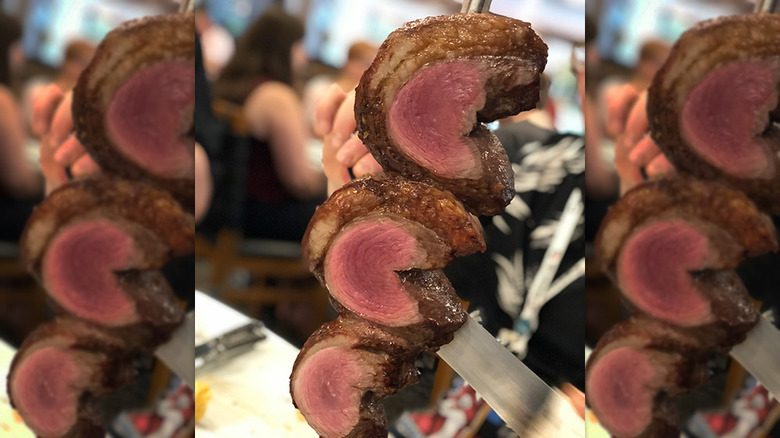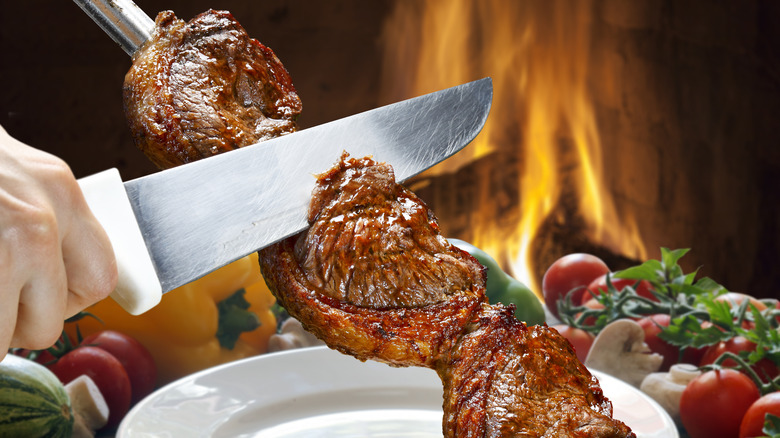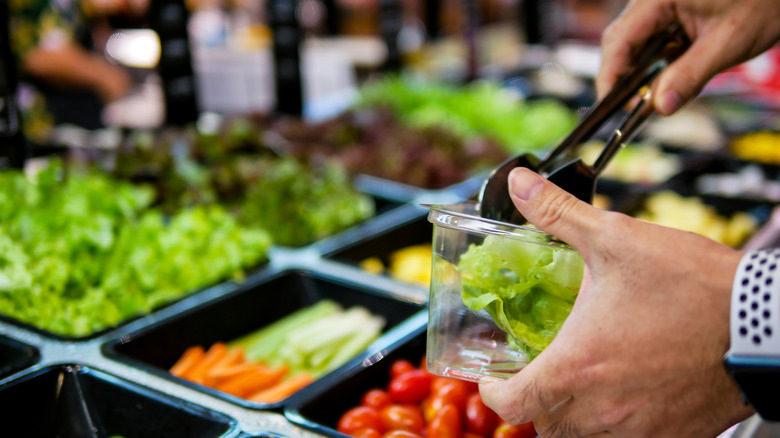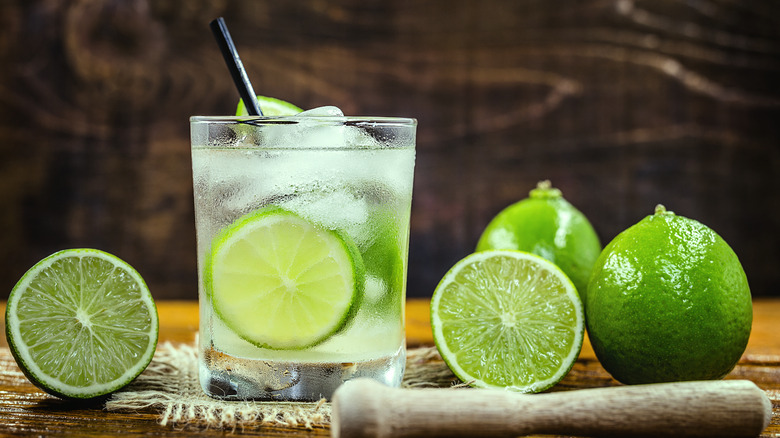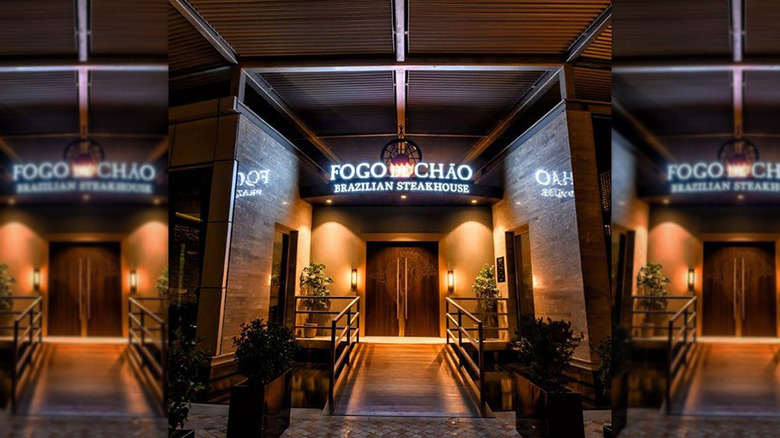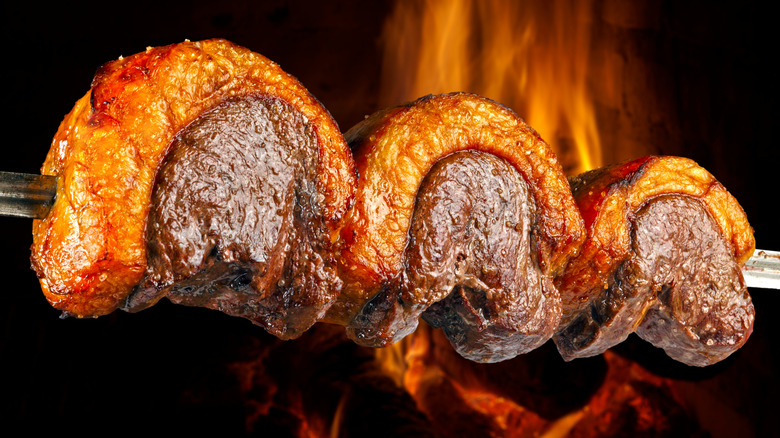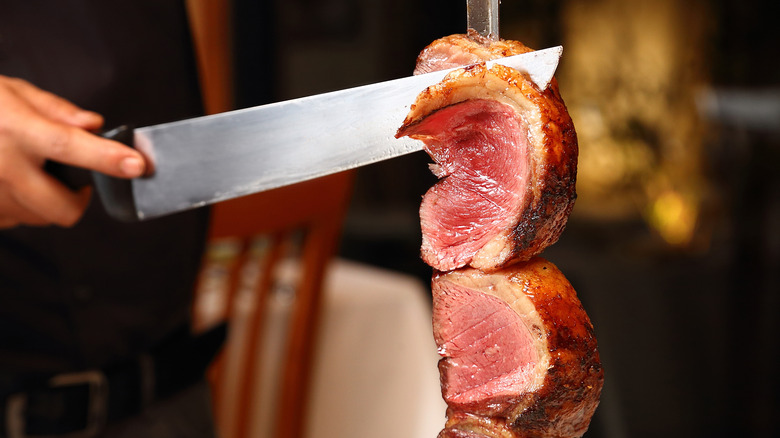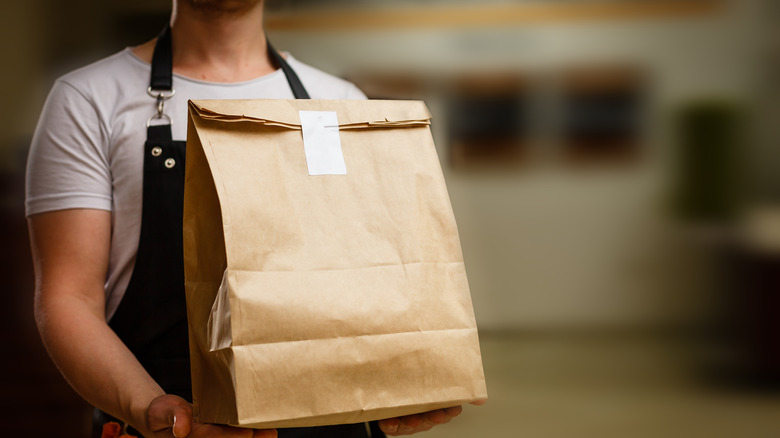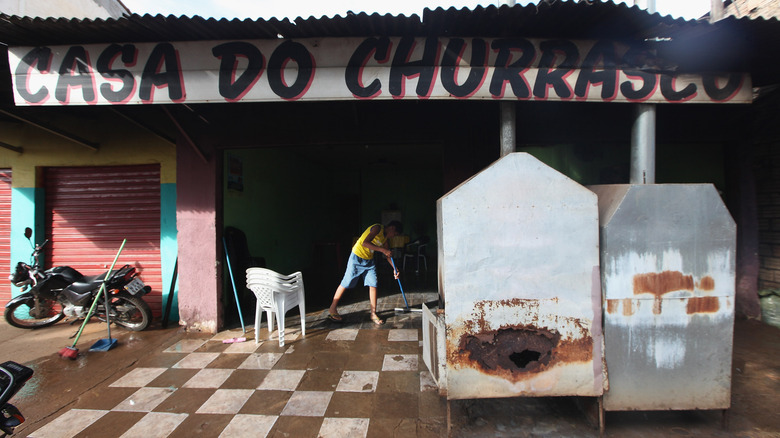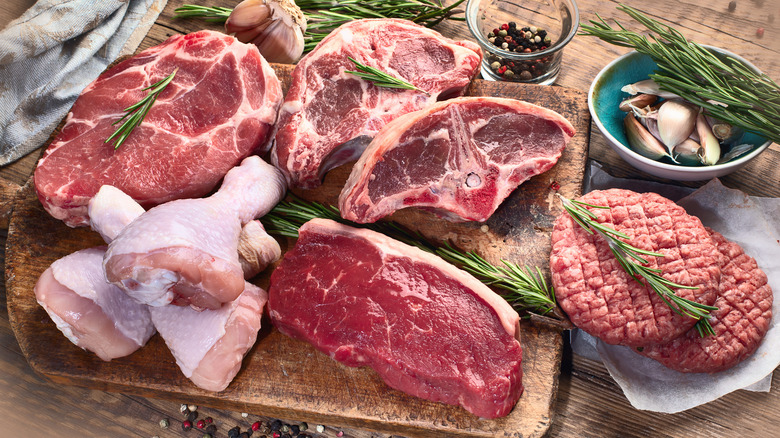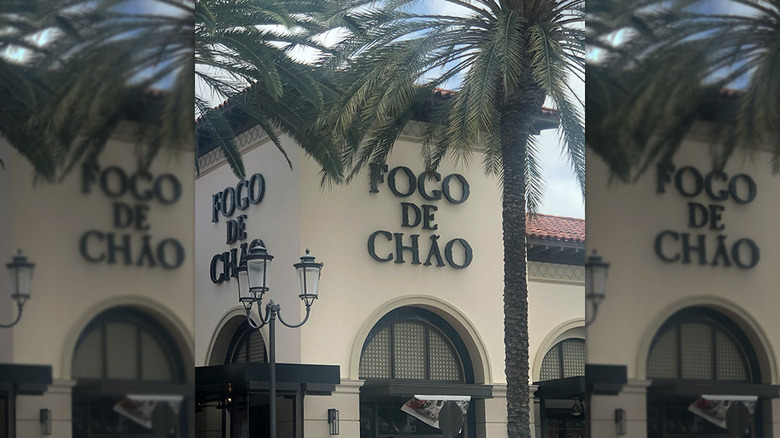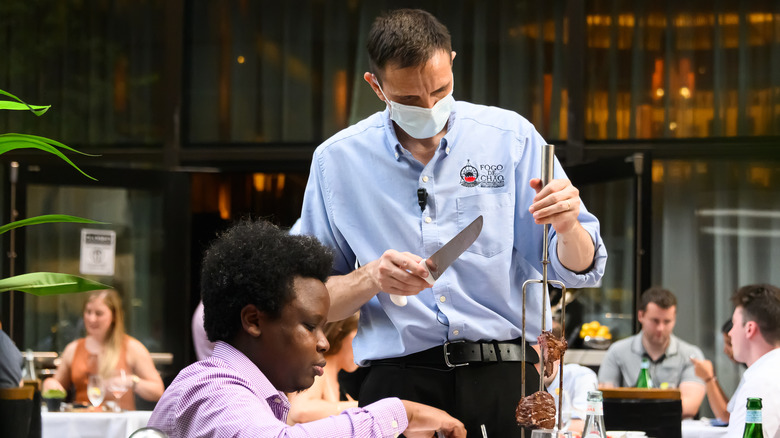The Untold Truth Of Fogo De Chao
For a long time, America's food culture was very, well ... American. But over the last few decades, more people in the US have wanted to try different foods and cuisines from around the world. This growing curiosity was the perfect entry point for a variety of culinary traditions. From Chinese to Mexican to Japanese food, Americans embraced new dishes — albeit ones that were largely redesigned for the Western palate. And with this discovery of new, interesting, and seemingly unique foods, home cooks and restaurant-goers across the country started casting their culinary nets wider, embracing even more foods that might have seemed "too" foreign in the past.
One restaurant chain that has successfully capitalized on this new curiosity around international foods is Fogo de Chão. The company now boasts 57 locations of its Brazilian steakhouse around the world. Unlike many restaurants serving international cuisine in the States, though, this chain actually started at the source in Brazil. This authenticity is largely what has spurred the company's continuous growth, along with a more upscale dining atmosphere and an interactive dining experience that allows diners to choose from different cuts of meat that servers almost theatrically parade throughout the dining room.
But somehow, despite the restaurant chain's relative fame, there are plenty of surprising facts about this restaurant that even its most die-hard fans may not be aware of. Brush up on your Fogo de Chão knowledge with these lesser-known facts.
The first Fogo de Chão was started in 1979
Many who have first encountered Fogo de Chão in the U.S. assume that the chain is American, but in reality, it's actually from Brazil. The first Fogo de Chão in the world was started in 1979 in Porto Alegre, located in Southern Brazil. This was almost 20 years before the company's expansion in the U.S., but it was a vital time for the restaurant to define itself and its reputation. This first location found its home in a wooden structure in the countryside ... just the kind of rustic restaurant you'd hope to find while on an adventure far from home.
Perhaps its biggest success was the fact that Fogo de Chão wanted to keep centuries-old culinary traditions alive — traditions specific to this particular region of Brazil. At the same time, the company focused heavily on top-notch customer service and excellent quality in the food and the dining experience alike. Perhaps most importantly, the restaurant wanted to celebrate and stay connected to the local culture. All of these factors lent themselves to a special experience that diners couldn't find in other restaurants at the time.
Fogo de Chão came to the United States in 1997
Fogo de Chão may not have been the first chain of Brazilian steakhouse restaurants in the United States, but it was largely responsible for the popularity of these kinds of eateries. Rodizio Grill was the first, opening its first location in 1995. But Fogo de Chão was only two years behind. The first US Fogo de Chão location opened in 1997 in Dallas, Texas. The company passed up cities like New York and Miami because it felt Texas was ideal: The state already had a strong barbecue culture, after all.
According to reporting by Eater, Arri Coser, one of the co-founders of Fogo de Chão, explained the decision by stating, "Texans have the same passion for meat that we gauchos [natives of Rio Grande do Sul] have, and all this barbecue culture, with a huge good herds. I saw a connection between the Brazilian gauchos and the Texas cowboys. So it seemed to be the best region to start." He also jokingly added, "Besides that, few Brazilians would know if it didn't work out."
Fogo de Chão focuses on churrasco
If you've gone to an American steakhouse before, you know just what to expect from a visit. You'll get to choose from a few familiar cuts of meat and a few sides that almost always include some form of potato. But an experience at Fogo de Chão is a bit different, as it focuses on a culinary tradition known as churrasco. Churrasco is the process of barbecuing beef and other varieties of meat that are cooked over a fire on a long skewer. Instead of ordering one whole cut of meat, diners get to taste a little bit of everything. These different types of meat are sliced off of the skewer directly onto the plate, so restaurant-goers know they're getting their food cooked fresh.
At Fogo de Chão, guests get the opportunity to enjoy a prix-fixe menu of these fire-roasted cuts of meat that are delivered to their table throughout the course of the meal. Because it's an all-you-can-eat experience, guests can sample a wide range of cuts and flavors, arguably offering a more exciting steakhouse experience than the American classic. It's truly a meat-lover's dream come true, especially for those who never seem to be able to settle on a single menu item.
Don't pass up Fogo de Chão's salad bar
Clearly, Fogo de Chão's specialty is the meat ... and lots of it. But that doesn't mean you're only stuck with heaping piles of beef on your plate. While it may be known for all that meaty goodness, guests shouldn't miss out on the salad bar either. This isn't just your average salad bar, though. At Fogo de Chão, it's known as the Market Table. This is where diners will find a variety of decidedly not-basic salads, imported vegetables and cheeses, proteins like smoked salmon, and yes, even more meat (not grilled, but cured). Of course, you can also grab some soup or a side salad if you want at least part of your meal to be on the lighter side. (We won't judge you if you don't.)
The Feijoada Bar is another can't-miss experience at this restaurant. Feijoada is Brazil's national dish, so patrons looking for an authentic Brazilian culinary experience certainly shouldn't pass it up. The dish is essentially a black bean stew, but it's also made with sausage. Feijoada is typically served with rice and farofa, or baked yucca flour. It's eaten with orange slices on the side, as the citrus brings some zest and brightness to the dish.
You'll find Brazil's national cocktail at Fogo de Chão
When it comes to the typical steakhouse experience, you'd probably think to order a glass of red wine with your meal. Fogo de Chão does have an extensive wine list and knowledgeable servers to help diners decide what they might like best. But those who want more of an authentic Brazilian experience might want to try the signature cocktail at this restaurant: the caipirinha. This is a classic sweet-and-sour cocktail that's an essential part of South American drinking culture.
It's made with just a few ingredients, and the simpler, the better. Like a margarita, the drink starts off with lime and sugar. But in lieu of the tequila, cachaça is the preferred spirit. Cachaça is a liquor similar to rum with a few slight differences in flavor — it tends to have a grassier taste. If you've never heard of this type of liquor before, you're not alone. That's largely because up until 2013, it was often marketed and sold in the United States as "Brazilian rum."
Though restaurant-goers will find this cocktail all around South America, it's not as common in the states, though it's getting more popular. If you want to try it for yourself, Fogo de Chão's got you covered.
You've probably been pronouncing the restaurant's name wrong
As Fogo de Chão has gotten more and more popular over the years and opened new locations all over the US, it's now well-known across the country and beyond. But one thing Americans haven't figured out about this restaurant yet? Most of us are actually pronouncing the name incorrectly. It's okay ... not everyone has to know how to speak Portuguese to enjoy the food there, but it's still a good idea to learn the correct pronunciation if you want to impress your friends (or your server) with your knowledge.
English speakers tend to pronounce the last word in Fogo de Chão like "chow," since we don't generally use the "ão" sound. However, the correct pronunciation is actually shoun or "shown." The first part of the name sounds just like it reads: fo-go dèe. The name means "fire on the ground," as that is how churrasco was originally made in Brazil.
Fogo de Chão's food is pretty authentic
Sure, you may have had Mexican or Chinese food before, but unless you've actually been to the source, there's a good chance that you were not getting an authentic version of another culture's food, but a more Americanized version. There's nothing inherently wrong with that — we all love us some General Tso's chicken — but if you really love experiencing new cultures, you'd probably prefer more of an authentic experience.
Luckily, Fogo de Chão offers just that. Since the chain started off in Brazil, it had to stay true to its roots. The patrons who came to the first Fogo de Chão knew what real-deal churrasco was, after all. Expanding into the US market didn't make the company water down its product or experience either. It wanted to bring a true churrasco experience to the country, and it continues to do so successfully to this day. From unique cuts of meat like picanha to the ultimate Brazilian cocktail, the caipirinha, guests can be confident that they're enjoying an authentic dining experience ... and that's not exactly common in chain restaurants.
The lunch option at Fogo de Chão's is a better value than dinner
Since Fogo de Chão is more of an upscale (albeit laidback) restaurant, guests can expect to drop some money at dinner, especially if they order drinks in addition to food. It's possible to get the same experience for less money, though. The main trick is to go at the right time. Dinner prices at Fogo de Chão are higher, as many view it as more of a dinner time experience. But the restaurant is open for lunch too, and the prices are more reasonable during that time.
The Gaucho Lunch is available on the weekdays, and it gives guests access to the Market Table and Feijoada Bar for just $15. While this offer doesn't include the unlimited meat selection, it only costs $8 to $10 more. Though these exact price points can differ by location, one thing is sure: Lunch is the more affordable dining option for those who want to save on their next Fogo experience.
You can actually get Fogo de Chão delivered
Back in the day, there were only a few types of food you could get delivered to your house, and (sometimes subpar) pizza was usually at the top of the list. But now, restaurants know that customers want to enjoy food in the comfort of their own homes. With the advent of food delivery apps like Uber Eats, restaurants have had to innovate new ways to get their dishes to customers, no matter where they might be.
Fogo de Chão may not seem like the most obvious restaurant to start a delivery wing of its business, especially since it does seem to rely so heavily on the in-person experience. But it really is possible to get a whole meal from Fogo delivered to your house. Customers can choose from churrasco combinations, which offers one type of meat and two side dishes. Feeding more than a few people? Fogo also offers deliveries of different meats by the pound, so you can stock up on your favorites or share with your whole party.
This restaurant is about the experience, but sometimes, guests want the flavor without having to leave the couch and get dressed up. While picking up your order from your front door may not be as exciting as waiting for a server to slice some fresh meat onto your plate, it does make it easier for customers to get their Fogo fill whenever they have a craving for it.
Fogo de Chão made rodízios more upscale
A new type of dining called rodízio was growing in popularity in Southern Brazil in the '70s (via Eater). The organization of the restaurant is exactly what we expect from Fogo de Chão now: servers coming around with grilled meat on skewers, giving a few slices to everyone in the room. Different restaurants from the region claim that they were the first to invent this "skewer run" style, but the true origin of rodízio is unclear.
These eateries were originally frequented by truck drivers who would stop at the roadside restaurants. Since there were plenty of cattle around, the food was cheap. More importantly, though, it was filling, which is just what hungry travelers were looking for. In the beginning, these eateries were more like gas stations than restaurants: The meat was usually cooked outside in tin-roofed rooms, and most didn't even have table seating at first. Drivers would often wait for their food, take it, and be on their way.
However, as this type of cuisine became more popular, restaurants started adding tables so patrons could sit down to enjoy their meals. Fogo was the restaurant that took the idea to the next level, though. The founders wanted to bring rodízio-style dining to the big cities instead of sticking to the side of the road. They also added an upscale flair to the atmosphere, complete with real glasses and white tablecloths. It successfully brought rodízio into a whole new age.
Fogo de Chão offers cuts of meat not common in the U.S.
Steakhouses in the U.S. generally have several different cuts of meat to choose from. Those who have made their rounds in the steakhouse scene will probably be able to identify the most familiar. Filet mignon, for example, has almost a legend-like quality about it, while the porterhouse steak has its own special following.
But when Americans take a trip to Fogo de Chão, they may not know what they're getting into. Fogo offers a wide variety of cuts that you usually just don't see in the States. It's an adventurous eater's dream come true. The picanha is probably the most well-known and celebrated Brazilian cut of meat, which means it's a must-try item on the menu. The medalhões com bacon is just what it sounds like: steak wrapped in bacon. And lamb may not be common in most American restaurants, but you can certainly find it here in the form of cordeiro. The costela, or beef short ribs, are also insanely popular.
Fogo de Chão is making inroads into the Middle East
Fogo de Chão got started in Brazil and expanded in its own country before making its way to the United States. Once there, the restaurant exploded in popularity. But the company had bigger ideas than leaving it at that. The restaurant chain added a location in Jeddah, Saudi Arabia, in August 2017.
Larry Johnson, the Chief Executive Officer of Fogo de Chão, spoke to the Saudi Gazette about the expansion: "Jeddah is such an exciting, dynamic city filled with unique restaurants from all over the world. We saw this as a great opportunity to become part of their growing culinary scene. We are thrilled to officially join the community and share our passion for Southern Brazilian cooking and hospitality with Saudi residents and visitors alike."
Of course, the traditional cocktails found at other Fogo de Chão locations won't be available in Jeddah, but the company did create a "mocktail" menu specifically for this location, offering visitors here just as many options to explore the flavors of the cuisine. In addition to the Jeddah location, Fogo has also expanded into Dubai.
Fogo de Chão stayed open with business relief loans
According to Nation's Restaurant News, the CARES Act, or the Coronavirus Aid, Relief, and Economic Security Act, was a $2 trillion aid package from the federal government to help alleviate economic suffering as a result of COVID-19 shutdowns, lockdowns, and loss of business and employment. A significant element of the CARES Act: the $349 billion Paycheck Protection Program, or PPP, which purported to help out specifically small businesses, defined as those with 500 workers or less. However, franchises and outlets of huge companies could apply if a single location employed fewer than 500. Among the major restaurant chains that received a loan from the PPP fund (which ran out of money in two weeks) was Brazilian-style steakhouse Fogo de Chão, accepting two separate $10 million windfalls. Company CEO Barry McGowan justified accepting money in this manner, telling the Wall Street Journal, "The scale of our business doesn't matter. All of our restaurants count."
Fogo de Chão pulled itself up out of potential pandemic disaster enough that in January 2021, it announced an aggressive and ambitious expansion plan. According to a press release, five new steakhouses will open in New York, New Mexico, Massachusetts, Florida, and Illinois, by year's end. These new locations will be among the first to feature a revamped interior design as well as The Butchery, meat shops where customers can buy high-end cuts to prepare at home.
Fogo de Chão staged a rapid and dramatic revival
Business did drop precipitously at Fogo de Chão during the coronavirus pandemic. According to Restaurant Business, same-store sales fell by 95 percent in the early weeks of the pandemic in spring 2020. When infection rates dropped and vaccination levels rose in the spring of 2021, restaurants cautiously started opening again, and Fogo de Chão performed spectacularly, with sales in March of that year up more than 17 percent above pre-pandemic levels. By June 2021, business at the steakhouse was 51 percent more than what it had been in June 2019. While the company experimented with pickup and delivery to stay afloat, the chain credited its financial revival to "a strong rebound in guest traffic as pandemic conditions have moderated" in its initial public offering, or IPO, filing with the Securities and Exchange Commission, becoming a publicly traded company in November 2021.
It wasn't the first time investors could buy and sell stock in Fogo de Chão. According to Nation's Restaurant News, the eatery became a publicly traded firm in 2015, and remained so until it was purchased by the Rhone Group in 2018.
